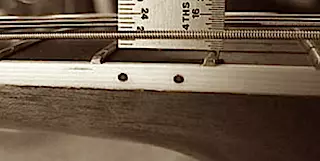Acoustic Guitars 101

Parts of an acoustic guitar.
Body
Many of the early guitar-making pioneers got their start in the cabinet-making business, often raiding old furniture for their materials, and while you aren't likely to find old teacups rattling around inside, an acoustic guitar body is akin to a sealed wooden dish cabinet.
The internal chamber is known as the sound box. The bigger the sound box, the louder the sound.
Acoustic guitars are made with slightly convex tops and backs for added strength and stability. Some players express concern when they first notice the curvature – but don't worry, it's normal!
Some models have a substantially rounded back, which adds volume without increasing depth, so the guitar doesn't end up being too cumbersome to hold.
A hundred years ago, what are now considered small-bodied guitars were standard, but since then acoustic guitars, like airplanes and American cars, have gotten bigger and bigger and Dreadnoughts and Jumbos now rule the day.
Bridge and Saddle

Until the late 19th century gut strings were the standard for both classical and folk guitars, but driven by the need to be heard over other acoustic instruments such as mandolins, banjos and fiddles, by the 1920s larger bodied steel stringed acoustic guitars became increasingly popular, and further differentiated from gut (and later nylon-strung) classical guitars.
Due to the greater tension of metal strings compared to the nylon strings found on classical guitars, acoustic steel string guitars require additional structural bracing under the bridge, where the strings are anchored to the body.
Neck
The higher tension of metal strings also requires a reinforcing metal truss rod to be built into the guitar neck. (Note that even though acoustic steel string guitars can support lighter-weight nylon strings, they aren't designed for it, and the reduced tension can bow or otherwise damage the neck).
Truss rods allow for adjustments to help compensate for seasonal variations in temperature and humidity, as well as changes in string tension when switching to different gauges or alternate tunings.
Soundhole
The soundhole serves as an opening in an otherwise sealed box.
When the top of the guitar vibrates, so does the air inside. While most of what we hear is projected from the guitar top, the size and shape of the soundhole plays a crucial role in the pitch and tone of the volume of air vibrating inside the soundbox. A larger soundhole usually (but not always) produces more treble, while a smaller soundhole usually (but not always) results in more bass response.

Neck and fretboard/fingerboard
Necks can be either a "set neck" glued to the guitar body, or a separate piece bolted on. Classical and acoustic steel string guitars usually have set necks, while bolt-on necks are more frequently found on electric guitars.
The width of the neck, as measured at the nut at the top of the fingerboard, ranges from about 1 11/16-inches on steel string guitars to 2-inches or more on classical guitars.
Even a small difference in the length and width of the neck and fingerboard can make a huge difference in how a guitar feels.
Wider fingerboards are more difficult to play for smaller hands, and aren't suited for all styles of music, but leave more room for complex fingerings. Finger-style players generally prefer wider spacing and favour nut-widths of 1 3/4-inches or more.
Scale Length
The distance between the nut (or zero fret) and saddle is the scale length.
Scale length is a determining factor in an instrument's intonation, tuning, tone, and string tension. Stretching the guitar strings over a longer scale length results in greater string tension, and potentially more volume.
Steel string acoustic guitars commonly have scale lengths that range from 24-inches (610 mm) on short-scale instruments to 25.5-inches (648 mm) on long-scale instruments. (The distance from the top nut to the 12th or "octave fret" marks the exact mid-point).
Classical nylon string guitars, following the designs of pioneering luthier Antonio De Torres (1817–1892) were traditionally made with scale lengths of 25.6-inches, but in recent decades the standard has evolved to 26-inches, which increases bass and volume.
Reduced-scale instruments designed for young students have scale lengths of 23-inches (580 mm) or less.
Action
The action is the distance between the strings and the frets. Holding down chords is hard enough, especially for beginners, and nothing discourages practicing – and progress – more than unnecessarily high string action.
Over time, with changes in temperature and humidity, necks can bow and warp. Guitars should be regularly serviced to make sure the neck is straight, and that string action is adjusted to an optimal height.








